
In botany, a bract is a modified or specialized leaf, especially one associated with a reproductive structure such as a flower, inflorescence axis or cone scale. Bracts are usually different from foliage leaves. They may be smaller, larger, or of a different color, shape, or texture. Typically, they also look different from the parts of the flower, such as the petals or sepals. A plant having bracts is referred to as bracteate or bracteolate, while one that lacks them is referred to as ebracteate and ebracteolate, without bracts.

Calyceraceae is a plant family in the order Asterales. The natural distribution of the about sixty species belonging to this family is restricted to the southern half of South America. The species of the family resemble both the family Asteraceae and the Dipsacaceae.

Gazania is a genus of flowering plants in the family Asteraceae, native to Southern Africa.

Pentachaeta is a genus of the family Asteraceae; the entire genus is endemic to California. Of the six species members, at least one, Pentachaeta bellidiflora, is classified as an endangered species. The etymology of the genus name derives from Greek: Penta = five + chaeta = bristle, referring to the pappus scales of P. aurea. It was combined in Chaetopappa, but later work led to the genus being recognized as definitely separate. It is most closely related to Rigiopappus and Tracyina. Pygmydaisy is a common name for Pentachaeta.
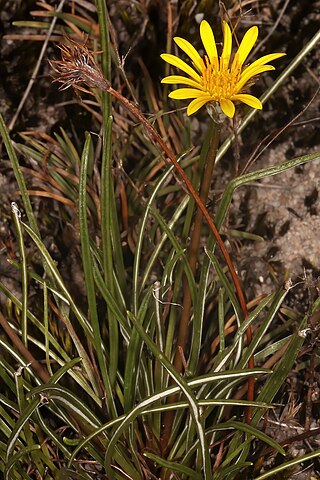
Gazania linearis is a species of flowering plant in the family Asteraceae, with thin linear leaves, native to South Africa.
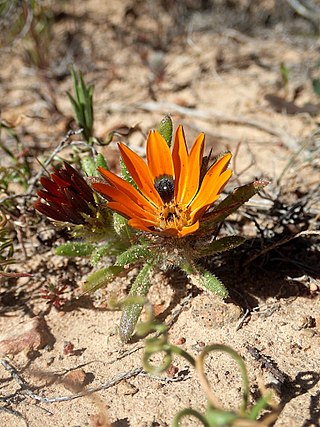
Gorteria is a genus of small annual herbaceous plants or shrubs, with 8 known species, that is assigned to the daisy family. Like in almost all Asteraceae, the individual flowers are 5-merous, small and clustered in typical heads, and are surrounded by an involucre, consisting of in this case several whorls of bracts, which are merged at their base. In Gorteria, the centre of the head is taken by relatively few bisexual and sometimes also male, yellow to orange disc florets, and is surrounded by one complete whorl of 5–14 infertile cream to dark orange ray florets, sometimes with a few ray florets nearer to the centre. None, some or all of them may have darker spots at their base. The fruits remain attached to their common base when ripe, and it is the entire head that breaks free from the plant. One or few seeds germinate inside the flower head which can be found at the foot of plants during their first year. The species flower between August and October, except for G. warmbadica that blooms mostly in May and June. The species of the genus Gorteria can be found in Namibia and South Africa.

Gazania krebsiana is a species of flowering plant in family Asteraceae. It is a low-growing herbaceous perennial native to Southern Africa, ranging from Angola, Zambia, and Mozambique to South Africa. It is one of some 19 species of Gazania that are exclusively African and predominantly South African - only Gazania krebsiana subsp. serrulata (DC.) Roessler ventures northwards from the Transvaal into tropical Africa.
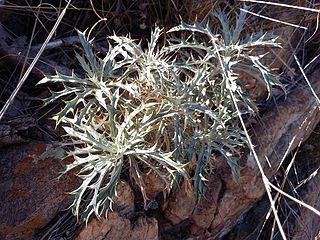
Berkheya carlinopsis Welw. ex O.Hoffm. is a Southern African herb or subshrub belonging to the family Asteraceae and was first described in 1896 in Boletim da Sociedade Broteriana 13 34.
A perennial herb or subshrub up to c. 1.5 m. tall. Stems branched, whitish araneose-tomentose, or glabrescent, leafy. Leaves sessile, 3–6 cm. long, dentate to pinnatifid-dentate; lamina 2–3(4) mm. wide and linear or 5–15 mm. wide and lanceolate; teeth 3–8 on each side, each tooth 2–6(10) mm. long, triangular or linear and extended in a tawny spine 2–3 mm. long; margins of teeth and sinuses entire or armed with smaller spines; upper surface smooth or somewhat scabrous, slightly to densely araneose-tomentose or glabrescent; lower surface whitish felted-tomentose. Capitula radiate, solitary and terminal on the branches, or subcorymbosely arranged, 2.5–5(+?) cm. in diam. including the rays. Phyllaries spreading, felted-tomentose outside, subglabrous or glabrous inside, 10–20 x 1–3 mm., linear-lanceolate, spiny-acuminate, ciliate-spinescent on the margins with spines 1–3 mm. long; the outermost phyllaries ± leaf-like with small spine-tipped teeth; inner phyllaries smaller and less spinescent-ciliate. Margins of the receptacular alveolae extended into straw-coloured bristles 1–2 mm. long. Achenes 1.5–3.5 mm. long, turbinate, 8–10-ribbed, strigose-sericeous, glandular-viscid at the apex. Pappus scales 2-seriate, 1–1.5 mm. long, narrowly oblong, acute or subobtuse, denticulate towards the apex.
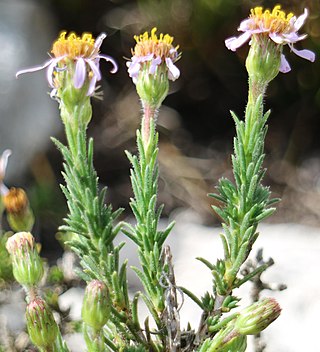
Felicia canaliculata is a grayish green shrublet in the family Asteraceae that grows up to 40 cm (16 in) in height. It has narrow, awl-shaped leaves, relatively large flower heads with approximately a dozen light purple to white ray florets encircling many yellow disc florets. It can only be found in the Western Cape province of South Africa.

Felicia macrorrhiza is a small, evergreen shrub in the family Asteraceae. This species grows in the Karoo region of South Africa. It is called Aspoestertjie in Afrikaans.

Gazania lichtensteinii is a species of flowering plant in the family Asteraceae, native to South Africa and Namibia. On the SANBI Red List, it is listed as "safe".
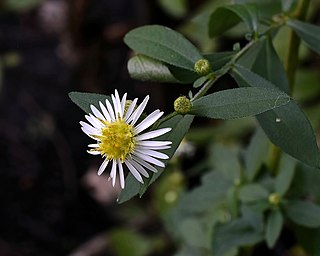
Symphyotrichum ontarionis is a species of flowering plant in the family Asteraceae native to eastern North America. Commonly known as Ontario aster and bottomland aster, it is a perennial, herbaceous plant that may reach heights of 120 centimeters. Each flower head has many tiny florets put together into what appear as one.

Felicia is a genus of small shrubs, perennial or annual herbaceous plants, with 85 known species, that is assigned to the daisy family. Like in almost all Asteraceae, the individual flowers are 5-merous, small and clustered in typical heads, and which are surrounded by an involucre of, in this case between two and four whorls of, bracts. In Felicia, the centre of the head is taken by yellow, seldom whitish or blackish blue disc florets, and is almost always surrounded by one single whorl of mostly purple, sometimes blue, pink, white or yellow ligulate florets and rarely ligulate florets are absent. These florets sit on a common base and are not individually subtended by a bract. Most species occur in the Cape Floristic Region, which is most probably the area where the genus originates and had most of its development. Some species can be found in the eastern half of Africa up to Sudan and the south-western Arabian peninsula, while on the west coast species can be found from the Cape to Angola and one species having outposts on the Cameroon-Nigeria border and central Nigeria. Some species of Felicia are cultivated as ornamentals and several hybrids have been developed for that purpose.
Hoffmannanthus is a monotypic genus of flowering plants in the Asteraceae. There is only one known species, Hoffmannanthus abbotianus(O.Hoffm.) H.Rob., S.C.Keeley & Skvarla Its native range is Uganda and southern Tropical Africa. It is found in the countries of Angola, Kenya, Tanzania, Uganda, Zambia and Zaïre.

Symphyotrichum kentuckiense is a rare species of flowering plant in the Asteraceae family and is commonly known as Kentucky aster, Price's aster, Miss Price's aster, Sadie's aster, or lavender oldfield aster. It is a perennial, herbaceous plant that is endemic to broken limestone cedar glades and roadsides in Alabama, Georgia, Kentucky, and Tennessee. It blooms from August through October, reaches heights between 30 centimeters and 100 cm (3.3 ft), and has green to reddish-brown stems. It is a nearly hairless plant with blue to blue-violet ray florets.

Gazania heterochaeta is a species of flowering plant in the family Asteraceae, native to South Africa and Namibia.

Gazania pectinata, the cockscomb Gazania, is a species of flowering plant in the family Asteraceae, native to the lower-lying regions and coastal plains of the Western Cape Province, South Africa.

Gazania rigida, the "Karoo Gazania", is a species of flower native to the Western Cape and Northern Cape Provinces of South Africa.

Gazania serrata is a species of flowering plant in the family Asteraceae, native to the Northern Cape and Western Cape provinces, South Africa.
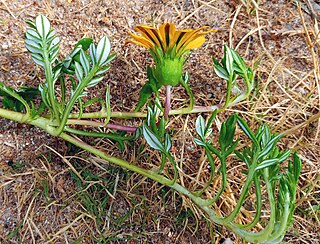
Gazania maritima is a species of flowering plant in the family Asteraceae, native to the Western Cape province, South Africa.




















